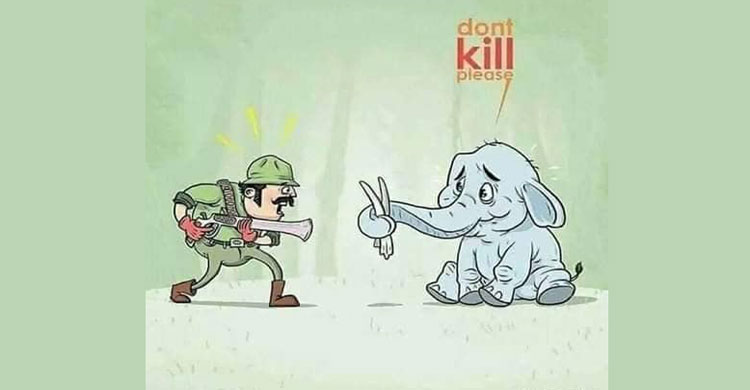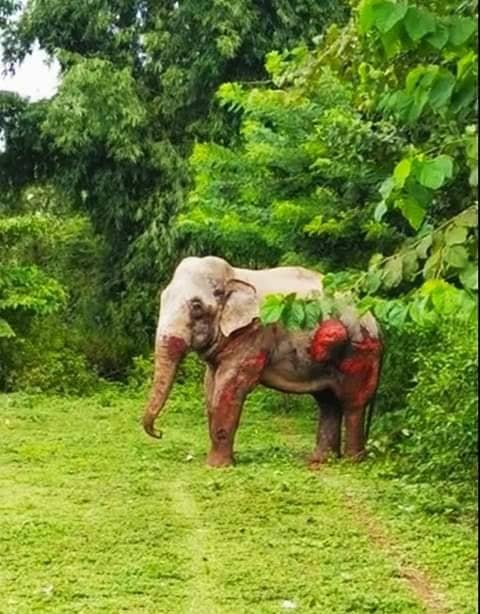When Cruelty is Reality: Scenario of Animal Cruelty and Protection in Bangladesh

Evnat Bhuiyan :
People used to enjoy the horse cart rides, popular in Gulistan of the Dhaka city. Have you ever noticed how inhumane the drivers are to them? Have you ever thought how unbearable pain the horses need to suffer all day long to carry you on? Probably, no. If anyone throws stones at you and causing you to bleed, how does it feel? surely not pleasant at all. When you visit zoo to thrill your child and to have fun, have you ever thought how the animals are being treated? Do you know they often need to suffer starvation and beatings before amusing you? When you saw a video on social media of beating a dog or cutting body parts of a cat, have your conscience ever been shaken with grief? Catching sparrows, pigeons, migratory birds and roasting them to meet your hunger might be interesting to your taste bud, but not a good thing to the nature. Slaughtering, killing, stoning, captivating without giving food, illegal selling- all the ways of animal cruelty, we practice every bit of it.
Animals do have emotions, they have feelings of joy, pain, anger, sorrow, sense of bondage of family and community, can also have emotional intelligence, as like as we have. So, if we can have rights to ensure our protection, why not the animals? These facts seem to be unrecognizable or unknown to most of the people of our country. People even do not wish to bother about animals and showing care to animals is often treated as a mockery in society on the misconception or excuse ‘Why do we need to bother about animal protection when we, humans are not getting ours?’
A culture of inhumane mind-set, abusing, ill-treating prevails among people,- a prime hindrance that needs to be tackled to ensure animal protection. It is found that mostly the young adults and children are doing cruelty to animal out of fun. Commercially the animals are being abused too. Despite the High Court Division’s ban on the dog culling, people keep doing this, breaking beautiful nests of birds though HC Division had a rule involving the consideration of taking the concern of protection of bird nests in a recent case.

‘No animal was ‘harmed’ during the shooting of this film’- we often watch these words in the starting of a film. Many national zoos are being regulated to protect animals and reduce abuse. Many countries are working on discouraging the zoo entertainment culture to aware about the sensitivity of animals and to promote animal protection. On a same note, ‘Animal experimentation’ is restricted totally or up to a certain level in conducting any scientific research and experiment, in many countries. These are the points which take the ‘Animal Cruelty’ into concern and bring it under legal protection.
A clarification among the terms ‘Animal Right’, ‘Animal Welfare’, ‘Animal Cruelty’ needs to be drawn out, before digging into the legal implication’s scenario of its protection. ‘Animal Rights’ are featured legally and morally as important as human rights by many animal right activists, which indicate- no animal should be killed irrespective of the purpose of that killing. On the contrary, ‘Animal Welfare’ denotes that there is no wrong in exploiting animals by causing least suffering or reducing the suffering to a minimum level. What animal welfare addresses is that, as long as you are not torturing, exploiting an animal by giving intolerable or unnecessary sufferings, it can be used.
Many countries believe animals or ‘non-human creatures’, deserve the same rights what humans do and a co-relation exists in between animal cruelty and human cruelty. Like- India has made protection of wildlife and compassion to living creatures as fundamental duty under Article 51A(G), in their constitution with massive range of laws including the major law- The Prevention of Cruelty to Animal Act, 1960. Using animals in scientific research and experiments by any organization or even school, college laboratories is strictly prohibited in India, which is absent in our country and ignored in the related legislations too.
We are still in a softer approach to this matter. Bangladesh, though not in serious stand here, has the essence to some extent in fundamental principles of State policy, Article 18A of Constitution of Bangladesh mentions protection of bio-diversity which says State shall endeavor to protect wildlife. Slaughtering animals in public places has been incorporated as a public nuisance indirectly under Section 268, Section 289 of the Penal Code, 1860 having connection to animal cruelty. The recent Animal Welfare Act, 2019 is an initial breakthrough and a notable development being a big positive approach to animal protection and welfare in Bangladesh so far. The first ever animal cruelty case in Bangladesh was filed in 2015 by Obhoyaronno, an animal welfare foundation.
Section 6(d) of The Animal Welfare Act, 2019 states,
‘Cruelty’ amounts to restricting an animal to such an extent and in such a manner that makes the animal unable to stand, sit or function in its natural ways.
Section 6(e) further elaborates that, cruelty does include unnecessary hurting of the animal using any sharp instruments while Section 6(h) highlights annoying the animal to be deemed as cruelty. But slaughtering animals for religious purpose will not amount to cruelty under this Act. So, in terms of legal implication, cruelty against animal is the punishable crime and legal actions can be taken in this regard as well. Section 14 of the Act contemplates to the procedure of filing a complaint:
- The one-stop solution is calling in the helpline 999 in case of witnessing any incident of cruelty to animal. Complain can also be filed in the nearest police station by filing a report with sufficient evidences.
- The nearest fire service or local government official can also be notified for providing assistance, in case the animal is not dead and still alive.
Section 10 of the Act is pivoted on punishment for damaging or removing organs of animals. Restricting movements of animal is punished with up to 6 months imprisonment or 10,000 Tk. fine or both, under section 16(a), while Section 16 (b) provides imprisonment up to 2 years or 50,000 Tk. fine or both, in case of an assailant committing damaging or removal of organs of animals.
Some of the remarkable feature of this Act is its compatibility and consistency with World Organization of Animal Health, Universal Declaration on Animal Rights and allowing painless death of diseased animal by euthanasia under the certification of a veterinary surgeon. Regarding farm animals and cattle, a crucial advancement is made in this Act as to restriction on intoxicating chemical substance or injecting non-prescribed or overdosing medicines into them. Whereas the previous Cruelty to Animal Act, 1920 defines animal as domesticated or captured, this new welfare Act has included street animals in it. But no clear remarks is made relating to cruelty against street animals like killing of dogs, though HC Division made rules on this earlier.
Bangladesh is also a ratified State of Convention on International Trade in Endangered Species of Wild Fauna and Flora (CITES), 1973 regulating trade sectors with the objective to ensure animal protection. More strict provisions on animal cruelty, involvement of NGOs government attention in stopping illegal business of animals, making an advisory board on animal welfare, development and preservation as well as creating awareness and educating people, especially children through academic curriculums- can foster the animal cruelty prevention and making an animal friendly society.
The writer is a Student, Department of Law, Jagannath University.

